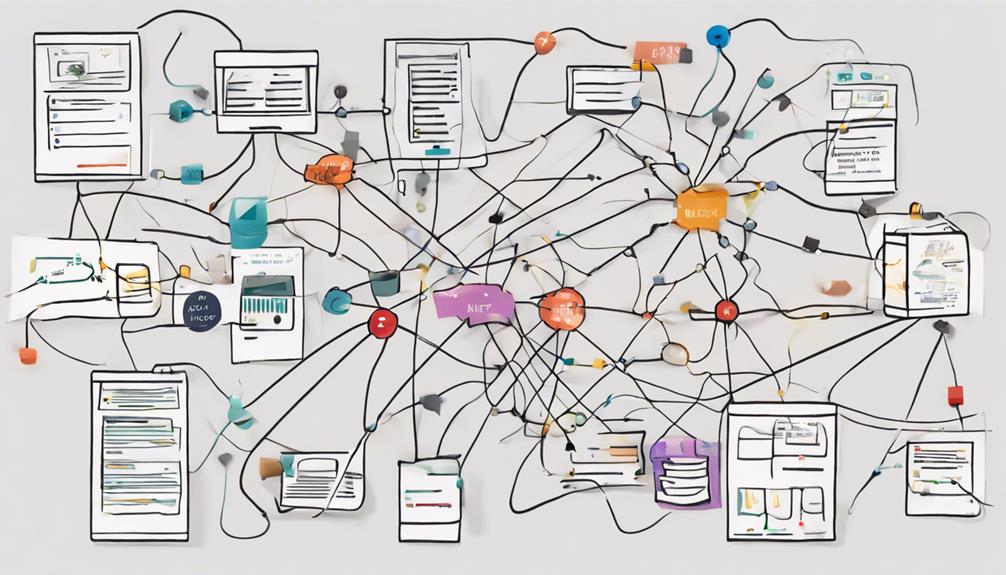When it comes to optimizing B2B data quality management, understanding the intricate balance between accuracy and efficiency is key. By mastering the art of identifying the right metrics and crafting a tailored strategy, you lay a solid foundation for success. But how can you ensure these efforts translate into tangible results that elevate your business operations to the next level? The answer lies in the execution. Stay tuned to discover the actionable steps and expert insights that can help you navigate the complexities of streamlining B2B data quality management effectively.
Data Quality Importance
Data quality is paramount in the realm of B2B data management. Ensuring data accuracy is essential for effective decision-making and successful business operations. Quality control measures play a vital role in maintaining high standards of data integrity. By implementing rigorous quality control processes, you can minimize errors and discrepancies in your B2B data sets, enhancing the reliability and trustworthiness of your information.
Data accuracy is the cornerstone of data quality, enabling you to make informed decisions based on reliable information. Quality control mechanisms such as regular data validation checks, deduplication processes, and data cleansing activities help identify and rectify inaccuracies in your datasets. These measures not only improve the overall quality of your data but also contribute to increased efficiency and productivity within your organization.
Key Metrics Identification
Identifying key metrics is a crucial step in optimizing your B2B data quality management strategy. Metrics analysis allows you to delve into the performance tracking of your data quality efforts, providing valuable insights into areas that require improvement. When identifying key metrics, consider factors such as data accuracy, completeness, consistency, and timeliness. These metrics will help you gauge the effectiveness of your data quality processes and pinpoint any bottlenecks in the system.
Start by establishing clear objectives for your data quality management strategy. Determine what success looks like for your organization and align key metrics with these goals. Look at metrics like data duplication rates, error detection and correction times, and overall data integrity levels. By tracking these metrics regularly, you can identify trends, patterns, and anomalies that may impact the quality of your B2B data.
Through a structured approach to key metrics identification and performance tracking, you can make informed decisions to enhance your data quality management practices and drive better business outcomes.
Strategy Creation
To effectively manage B2B data quality, it is crucial to begin by meticulously planning your strategy. Aligning this strategy with your business objectives ensures that data quality efforts are in sync with organizational goals. Embracing a continuous improvement approach enables you to adapt your strategy as needed, ensuring sustained success in managing data quality in the B2B environment.
Planning Data Quality
With a focused approach to enhancing the quality of information within your organization, crafting a robust strategy for planning data quality is paramount. Data governance plays a crucial role in this process, establishing guidelines and protocols for managing data effectively. Implementing clear policies regarding data ownership, security, and integrity is essential to ensure that your data remains accurate and reliable.
When planning data quality, it is also vital to consider data cleansing techniques. Data cleansing involves identifying and correcting any errors or inconsistencies in your database. By regularly cleaning your data, you can eliminate duplicate records, standardize formats, and remove outdated information, thus improving the overall quality of your data.
To create an effective data quality plan, start by conducting a thorough assessment of your current data quality levels. Identify areas of improvement, set specific goals for enhancing data quality, and establish metrics to measure your progress. By developing a comprehensive strategy that incorporates data governance principles and data cleansing practices, you can lay a solid foundation for maintaining high-quality data within your organization.
Aligning With Objectives
Crafting a data quality strategy that aligns with your organization’s objectives is a critical step in ensuring the effectiveness and success of your data management efforts. Goal alignment is key; your data quality strategy should be directly linked to the overarching goals of your organization. By integrating your data quality objectives with your company’s broader mission, you ensure that every effort contributes to the strategic direction. This alignment also allows for process optimization. Identify areas where data quality improvements can enhance efficiency and support the achievement of business objectives. Efficiency enhancement should be a core focus, streamlining processes and workflows to maximize the impact of your data quality initiatives. Through objective integration, your data quality strategy becomes a powerful tool for driving business success. By ensuring that every data management effort is purposefully directed towards your organization’s goals, you lay a strong foundation for effective data quality management.
Continuous Improvement Approach
Aligning your data quality strategy with your organization’s objectives sets the stage for a continuous improvement approach that is both strategic and results-driven. To ensure sustained success, incorporating data governance practices is crucial. Establish clear roles and responsibilities, define data quality standards, and implement processes for ongoing monitoring and enforcement. Data governance provides the framework for maintaining data accuracy, consistency, and reliability over time.
Automation tools play a pivotal role in supporting a continuous improvement approach to data quality management. By leveraging automation, you can streamline data cleansing, enrichment, and validation processes, reducing manual errors and accelerating data processing. Implementing automated data quality checks at various touchpoints within your systems enables real-time monitoring and corrective actions, ensuring data integrity at all times.
Regularly reviewing and refining your data quality strategy based on insights from data governance practices and automation tools is key to driving continuous improvement. By fostering a culture of data quality excellence and embracing iterative enhancements, you can adapt to evolving business needs and maintain high data quality standards effectively.
Solutions Implementation
Implementing solutions for B2B data quality management requires a strategic approach that focuses on addressing specific pain points within your organization. To start, consider technology integration to streamline data processes and enhance accuracy. By integrating advanced automation tools, you can reduce manual reviews, saving time and minimizing errors. Process optimization is key to ensuring that data flows efficiently throughout your organization. Implementing automated data validation processes can help maintain data integrity and consistency across systems.
When selecting solutions, prioritize tools that align with your specific data quality objectives. Conduct a thorough analysis of your current data management practices to identify areas that can benefit from automation and technology integration. Ensure that the solutions you choose are scalable and adaptable to future business needs. By strategically implementing solutions that focus on technology integration, process optimization, and leveraging automation tools while reducing manual reviews, you can enhance the overall quality and reliability of your B2B data management processes.
Regular Monitoring
For effective B2B data quality management, regular monitoring plays a crucial role in ensuring ongoing accuracy and reliability. Implementing automated alerts within your data management system can help in proactively identifying and addressing any anomalies or discrepancies. By setting up these alerts based on predefined thresholds or rules, you can stay informed in real-time about any potential data quality issues that may arise.
Furthermore, incorporating regular data validation checks as part of your monitoring process is essential. Data validation ensures that the information being collected and stored meets the required standards and is error-free. This step helps in maintaining the overall quality and integrity of your B2B data.
To streamline the monitoring process, consider establishing a schedule for routine checks and reviews. This structured approach will help in identifying and resolving data quality issues promptly. By consistently monitoring your data quality through automated alerts and data validation, you can proactively maintain accurate and reliable information within your B2B database.
Staff Training
To ensure optimal B2B data quality management, providing thorough staff training is imperative. Effective training programs are essential for skill development and ensuring that your team is equipped to handle data accurately. Here are some key points to consider when implementing staff training for data quality management:
- Customized Training Modules: Tailor training sessions to address specific data quality challenges your organization faces. This approach enhances training effectiveness by focusing on relevant scenarios and solutions.
- Hands-On Workshops: Incorporate practical exercises and simulations into training sessions to allow employees to apply theoretical knowledge in a real-world context. This hands-on approach accelerates skill development and reinforces learning.
- Continuous Feedback Mechanism: Establish a feedback loop where employees can provide input on the training content and delivery. By actively seeking feedback, you can enhance training effectiveness, address gaps, and ensure that staff are acquiring the necessary skills for effective data quality management.
Frequently Asked Questions
How Do I Ensure Data Security and Privacy in B2B Data Quality Management?
To ensure data security and privacy in B2B data quality management, encrypt all sensitive information. Maintain compliance with regulations. Implement strong data governance practices. Provide thorough training to employees on handling data securely.
What Tools or Software Are Best for Automating Data Cleansing Processes?
Looking to streamline your data cleansing processes? Why not explore tools like data enrichment platforms that leverage machine learning algorithms for automated and efficient data cleansing? These advancements can significantly enhance your B2B data quality management.
Can Outsourcing Data Quality Management Be a Viable Option for B2B Companies?
Outsourcing data quality management for B2B companies can offer advantages. Consider your in-house expertise and conduct a thorough cost analysis. Evaluate the benefits of external specialists in streamlining processes and enhancing data accuracy for improved business outcomes.
How Can B2B Companies Effectively Integrate Data Quality Practices With CRM Systems?
To effectively integrate data quality practices with CRM systems, ensure seamless data integration, aligning with CRM processes. Implement robust data governance to maintain compliance requirements. Regularly audit data quality within CRM for accuracy and consistency.
What Are the Common Challenges Faced When Transitioning to a New Data Quality Management Strategy?
Transitioning to a new data quality strategy can pose challenges. Data migration may lead to lost or corrupted information. Change management is vital to ensure staff buy-in and successful implementation. Stay vigilant to avoid setbacks.



